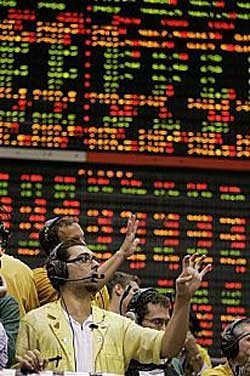 |
Last Wednesday in this space, I strongly implied that for a good number of individual investors, it was probably wise to just turn off the financial-news media and “hit the hammock” for the long weekend. Trading volume was so sparse that I reckoned it was dominated by a sort of “zombie trading” by quantitatively inclined, short-term professional investors — most of whom employ automatic trading models.
Very few critical (buy, hold or sell) decisions were being made by human investors employing fundamental or other means to initiate, alter or close out positions. So rather than engaging in an exercise in foolishness, trying to out-compute the short term-focused computing power unattainable by most of us, I thought that for most individual investors, the weird week should be treated as a period of opportunity to reflect, to see — from a human perspective — where one’s risk tolerances lay.
And even if the equity markets were making new all-time highs due to this zombie trading, there seemed to me to be an appreciable absence of risk assessment in last week’s market action — which means hidden danger for individual investors. So in essence I was advocating just ignoring what I saw as aberrant action. Take a break, and reassess your risk tolerances during a period of extremely low volatility (the “fear index,” the VIX, has been hovering near all-time lows in recent days), was my message to investors. I live and work under the notion that over the long term, markets reward solid fundamentals, but over the short term, “noise” dominates.
The hardest lesson, and one of the most valuable that a good number of long-term market participants have ever learned about investing, is that short-term action observed may or may not have any analytical value as to whether their holdings or prospective holdings are properly valued. It’s irresponsible to completely dismiss the noise factor, as aberrant action over the short term may be a prelude to things to come. However, for the most part noise is just that — noise.
For savvy investors, times of aberrant trading like last week provide a distinct opportunity to add new names and to shed current holdings, as the non-human factors driving the action overshoot to both the upside and the downside.
I use a proven long-term quantitative system of algorithms to identify when individual equity issues stray too far — to the upside and to the downside — in the short term in relation to those same equities’ long-term value. By long-term value, I’m referring to the Weiss Ratings model, which sends signals related to this short-term variation away from long-term intrinsic value. The Weiss Ratings are sensitive to these short-term effects, and the basis of the analysis I use to run the Weiss Million-Dollar Ratings Portfolio combines what has happened in terms of fundamentals (long-term signals) with what has also happened recently (short-term signals).
 |
| Most short-term action adds little to your portfolio’s value. |
So what’s the combination of these analytical tools yielding at present?
Overall the Weiss Ratings had been deteriorating in terms of bullishness in recent months, even as the market grew — in zombie-like fashion for part of the rise. When the ratings are decreasing and the market is increasing, this serves as a yellow flag — sometimes a red one — I retreat or at least remain wary of adding to long positions.
That said, and as members of my service know well, I use what foresight I can add to the current state of the ratings results to position a real-money portfolio to pick up highly rated, low recent-performance stocks, and to shed declining-ratings, high recent-performance stocks. The idea is to stick to what “works” in the market, and to identify unloved future gems.
Right now, the Weiss Ratings have — after a head-fake to the upside and a subsequent wilting — hit a supportive relative bottom, meaning they have stabilized and should rebound. At the same time, the market is falling in the run-up to second-quarter earnings, after running up without fundamental support for the past few months. This may be viewed as a normal consolidation after a run toward new highs. But right now we’re waiting on some very important earnings news, and more importantly, bullish company management outlooks for the rest of 2014. We may not get it, so there is a distinct possibility that stocks could pull back based on this short-term news.
However, as long as the Weiss Ratings continue to strengthen, I plan to add long equity exposures throughout the rest of the summer and beyond. Should the ratings begin to falter again, I’ll reconsider. But for now it looks like we are in a positive trend. The defensive sectors have held fast in terms of Weiss Ratings throughout this period of overall weakening, and I think we’re seeing a bottoming in the more pro-cyclical areas of the economy.
Energy is still a standout in terms of this strengthening, and I expect that to continue. Whereas Industrials and even Tech have absorbed much of the negative fundamentals reported in 1st quarter earnings season, and are now being affected by more emotional than analytical drivers. This could reverse quickly. But I see more of a smooth bottoming process taking hold over the next few weeks.
Best,
Don Lucek

{ 1 comment }
More bubbles on their way .